Oculus Rift Review: Grab Your Virtual Shotgun
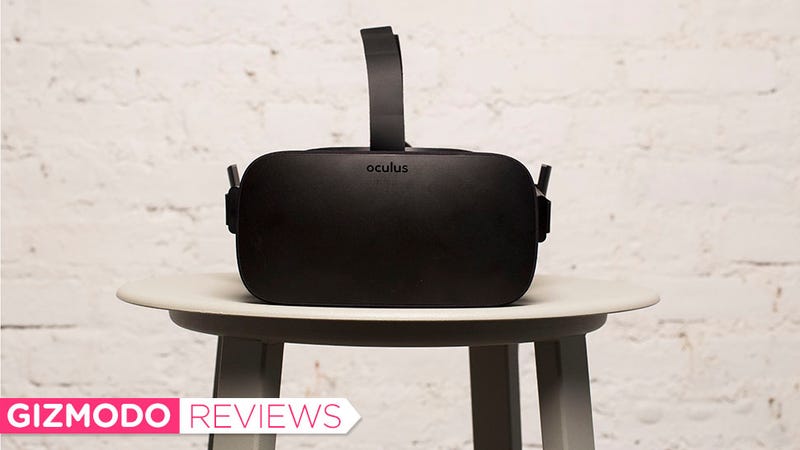
Virtual reality has never really convinced me it’s worth the hassle. The roughly developed attempts so far never seem to justify the awkward hardware or the stomach queasiness. Even after strapping on one of Oculus’ early development headsets and seeing something really cool, I was out of there within twenty minutes and wondering more about lunch than when the future would arrive in my living room.
So imagine my surprise when, after pulling off the final version of the Oculus Rift during a recent session, I realized I had been playing for more than an hour. It was dark out, and all my coworkers had gone home. I’d been lost in the moment, trying to collect all 20 hidden red coins in a level of Lucky’s Tale, one of the 30 games launching alongside the Rift today.
I’m no longer a hardcore gamer, but I’ve had my fair share of caffeine-fueled gaming all-nighters, so I’m familiar with the dazed feeling of coming to after losing myself to an illusion. I looked at my watch. It was just after seven. Do I have anywhere to be? Nope. I rubbed my eyes, pulled the headset down over my face, and went back for more.
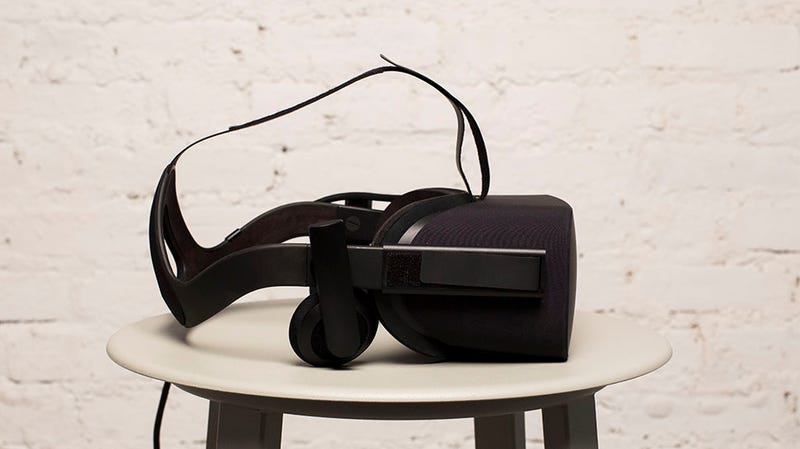
This has been the promise of Oculus all along: a truly immersive virtual reality experience. From the beginning, when Oculus was first introduced as a Kickstarter, the nerds were already on board—legions of gamers and early adopters were ready to buy into virtual reality before they even saw it themselves. For the rest of us, VR has remained an elusive and tedious source of hype. It’s all talk about the future and the possibilities that lie ahead, but for the most part, it’s been a future we can’t see. And when virtual reality doesn’t fill a need, the way a smartphone does by putting the internet in your pocket, the technology is hard to get excited about.
Even if you’ve had a glimpse of VR’s “promise”—with Google Cardboard, Samsung Gear VR, or an early Oculus development kit—and were wowed in the moment, it was probably more excitement about what it could become, rather than what it was.

Because the best content on the best VR viewers until now has sucked. Oculus’ first two headsets were uncomfortable and cumbersome; the image quality has never been realistic enough to transport you to another world entirely; and worst of all, the screens inside the headsets can’t keep up with head movement fast enough to keep people from getting sick.
But now we have the Rift—the final version. A finished consumer product that delivers a polished experience that can be appreciated not just by the nerds.
Preparing to go virtual
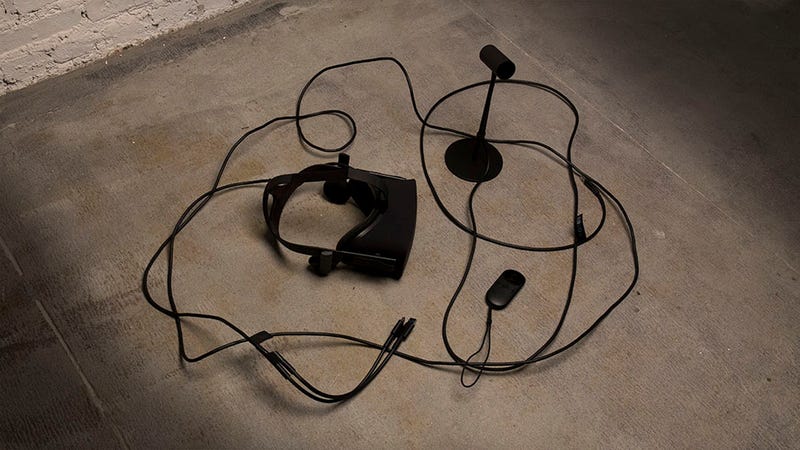
The moment you pull the Rift’s retail package from its brown shipping carton, you can tell it’s a different device this time around. A white glossy sleeve encloses a dramatic black box that flips open like a flight case. Everything is nestled into a molded spot, and a sticker on the inside-top flap invites you to a setup website, from which you’re guided step by step through the installation.
Oculus has gone to pains to mimic the experience of famously simple consumer products (ahem, Apple) right from the start. It’s a valiant effort for a lumbering headset you’ll eventually have to strap to your face, and make no mistake—this process is hardly simple. There’s a lot of stuff in this box:
- The headset with its tether cable that connects to your computer
- The Oculus sensor and stand, which track the position of the Rift on your head.
- The compact Oculus remote, which allows you to navigate menus and adjust the volume while you’re wearing the headset.
- An Xbox One controller for playing games, and the USB adapter that wirelessly connects the controller to your computer. (At launch, Oculus’ motion tracking Touch controllers won’t be available. According to the company, they’ll be out later this year.)
And that’s not really all of it, unless you already have a sick gaming computer. Along with our review unit, Oculus sent us one of its Oculus-ready PCs: a $950 Asus tower with a Nvidia Geforce GTX 970 graphics card, which costs more than $300 on its own, and a chassis bedazzled with customizable glowing LEDs that make the thing look like some mysteriously powerful chunk of alien spaceship.
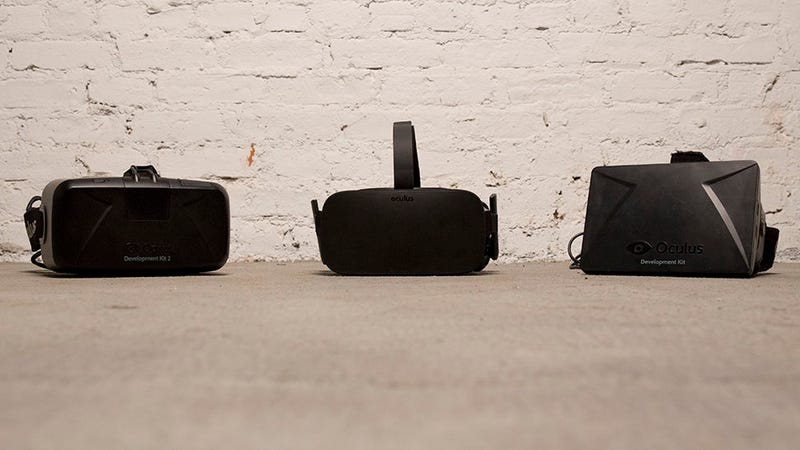
After about an hour of unboxing and plugging in a gazillion cables, you’re ready to actually start setting up the software, which takes another 20 minutes to download. From there, the step-by-step installation is a breeze, and requires zero technical know-how. It’s hardly as easy as plugging in a new MacBook, but having had the displeasure of assembling and installing Oculus development kits, I can tell you that this new process is nothing short of revelatory.
The new Oculus headset looks like an all-black pair of ski goggles with sturdy straps to affix it to your head. Holding it in both hands, it feels like about the weight of a pound of ground coffee. Inside are two modestly adjustable lenses, which are your portholes to the OLED display. The headset has integrated on-ear speakers, which rest comfortably on your head and remove the need for additional cords latching you to your PC. There’s only one bundle of cords snaking out from the headset, and with the exception of that pesky primary tether, which every so often catches a snag and pulls you out of your virtually transported state, Oculus has succeeded in making something that looks and feels like a premium consumer electronic device.
This ain’t your dad’s VR
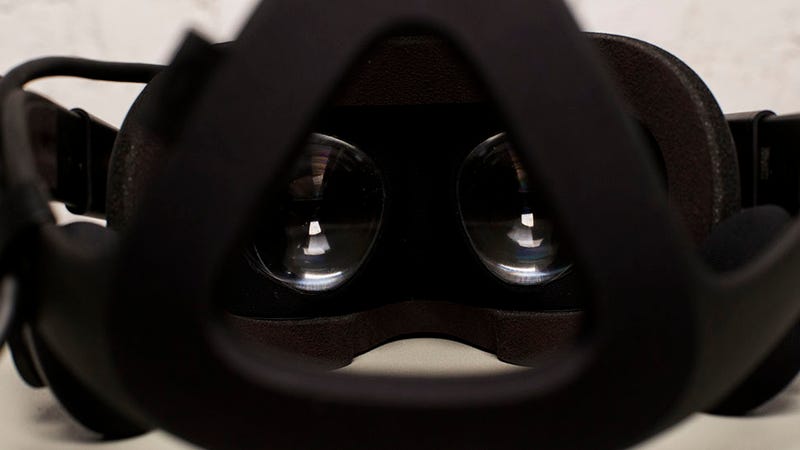
I’ve never understood Oculus’ insistence that you need to be standing to use the Rift. Until more movement-oriented experiences exist—and the Touch motion controllers are available—sitting in a swivel chair allows more than a sufficient range of movement. Although it’s weird to see how far you’ve rolled away from a desk when you emerge from the void beyond.
Once you’ve put the thing on your head, you’re presented with a simple UI, called Oculus Home, which allows you to browse apps in your library and the Oculus store, where you can download more. Many of the apps are huge, and on crowded broadband, I was more likely to leave them downloading overnight than sit at the computer twiddling my thumbs.
In virtual reality, moving your head changes the perspective of the image you’re viewing, as if it was actually in front of you. You interact with the virtual world using a manual input device, like an Xbox One controller or the Oculus remote. To navigate the UI, you simply point your head at what you want to interact with, and click on it with your controller. The movement is smooth, and pointing your head at something inside the Rift is basically identical to turning your head in real life. Just make sure you know where the controller is when you put the headset on, or you’ll have an unpleasant moment blindly fumbling around for it.
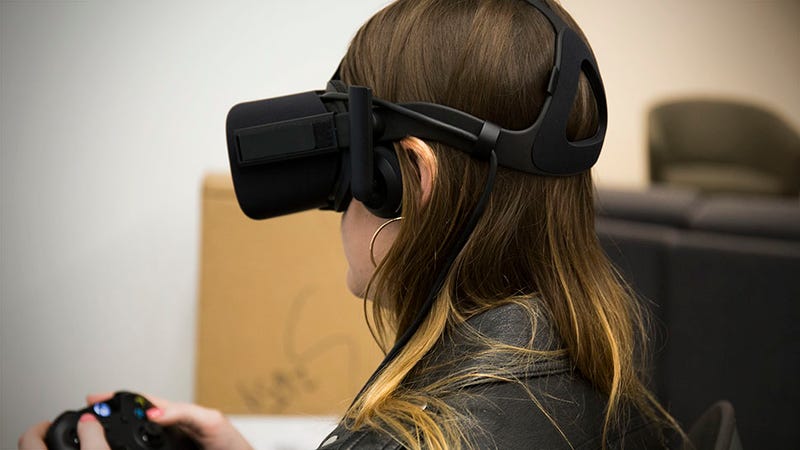
The available apps hint at the potential for the Rift beyond gaming, but they’re not ready for prime time. Oculus Video, for example, allows you to view 360 and 2D content through the headset. (It includes a mandatory subcategory for 360 videos on Facebook, which now owns Oculus.) When watching movies in “lean back” mode, I find myself much more aware of the headset then when I’m playing games. It’s really no better than watching a movie in a darkened room. There are other experimental apps, like a VR tour of the human body, but they’re not that interesting. It’s all more future than now.
All fun and games
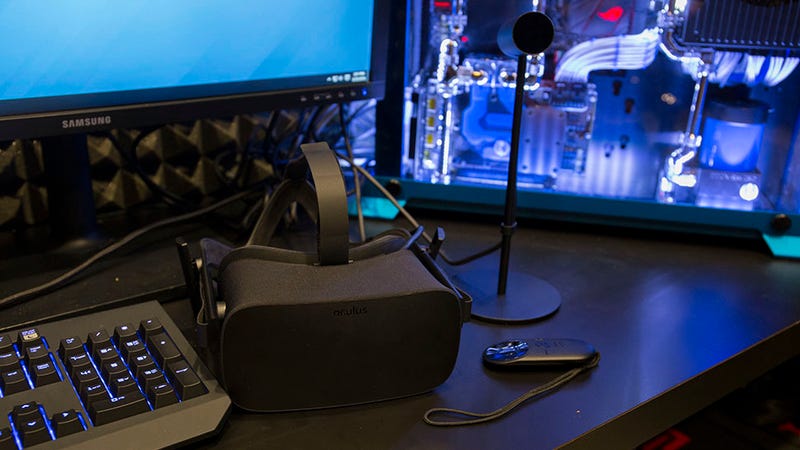
The Rift was really designed as a gaming device, and this is where it shines. After sampling a few titles, it’s clear that the simpler the controls for a game, the more enjoyable and immersive I found the experience. I had the most fun playing the whimsical and childishly simple Lucky’s Tale, in which you play a cartoon fox hopping along in the world, racking up points, evading enemies, and completing challenges.
People in the office who had less gaming experience found Lucky’s Taleimmediately intuitive too, and it shows how a VR headset can actually simplify gaming and make it more accessible. Most traditional 360 games (think Call of Duty or other first-person shooters) require two kinds of directional inputs (joystick or arrows on a controller)—one of them controls “the camera” or the way you’re facing, and the other controls your directional movement. Combining them seamlessly requires a fair amount of coordination, but a VR headset takes care of the camera view, which makes it a lot easier. Gunjack, the arcade shooter, is easy to master because you point your head in the direction of vessels you need to shoot out of the sky. It’s fun and super satisfying, without a huge learning curve.
On the opposite end of the spectrum is Eve: Valkyrie, a space simulator spin off ofEve Online, which is probably the type of title hardcore gamers are looking for. Since I’m not one of these gamers, the controls for piloting the spaceship were tough for me. I found myself getting sick after about five minutes, and the missions were so stressful and intense that I threw off my headset. It’s not surprising that making a realistic and enjoyable spaceship simulator would be difficult, and I did get better over the week. But I’m still not hurting to play the game.
The failings of the future
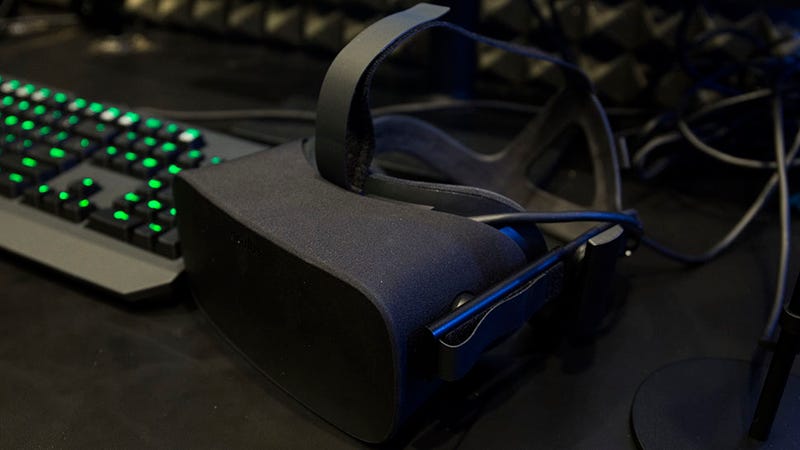
I’m not saying it would be impossible for me to adjust to Eve: Valkyrie eventually, but a period of adjustment is exactly what Oculus is trying to eliminate. The company has worked for four years to make a product accessible enough for anybody. This title, and others like it, are going to fall painfully short of the mainstream accessibility Oculus wants to achieve in the long run—no matter how much the technology improves.
While we’re on flaws, I’ll add a few more. There are still moments when you see hints of “screen-door effect”—wherein the space between pixels is visible, because the OLED displays are almost on top of of your eyeballs. The effect is akin to seeing the world through a screened-in porch. Plus the image is occasionally blurry, and the sweet spot for the lenses feels elusive and small. At times, it’s like you’re staring through a tunnel at the image, insofar as the edges of your field-of-view look artificially cut off.
Then there’s the price. The Rift package alone costs $600. Add the $950 PC we used, and you’re looking at a total of $1550. It’s a shitload of money, and probably enough to mean Oculus will remain mostly niche. In other words, even if Oculus made a device that’s accessible to all, it’s still pretty much only for gamers. If you’re one of those people who is ready to drop that kind of coin, you should wait for next week’s reviews of the HTC Vive, which has a headset with similar specifications to the Rift.
What Oculus has accomplished is remarkable. There’s plenty that even the completely uninitiated user can enjoy. More importantly, the Rift is truly immersive in most cases. The image quality is mostly excellent, and the head-tracking is nearly flawless. Indeed, perhaps what’s most significant is that there are moments when I can say unreservedly and without caveats that I am enjoying the Rift right in the moment—not as a device indicative of some desirable future, but as a device to own right now. I still can’t afford the future of virtual reality, but for the first time, I actually want to.
README
- Oculus Rift is fun. Seriously, man, playing games is fun.
- The Rift is miraculously easy to install and use.
- The experience is wholly immersive, and doesn’t make you want to vomit (most of the time).
- More complex and disorienting games will still turn your stomach.
- The Rift is mostly good for games right now—everything else is bogus.

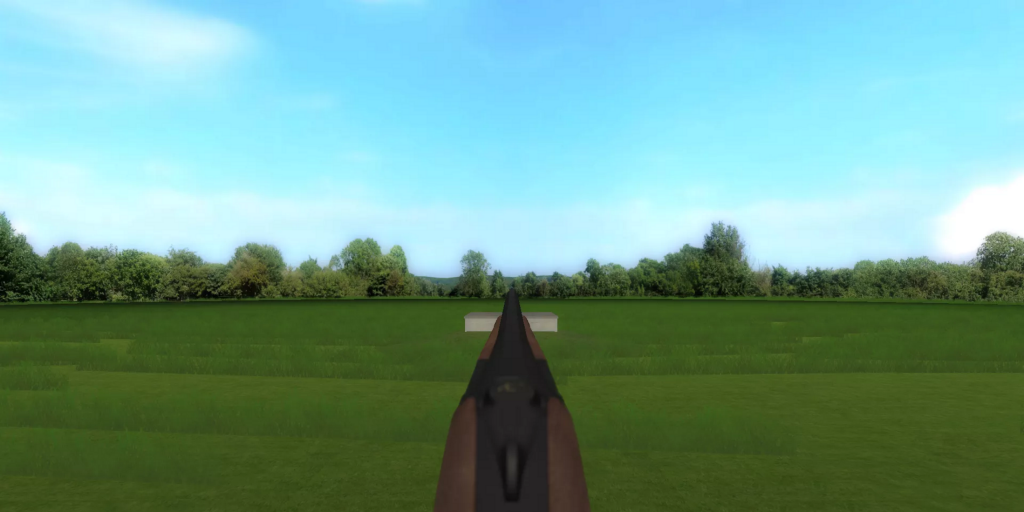

Leave a Reply